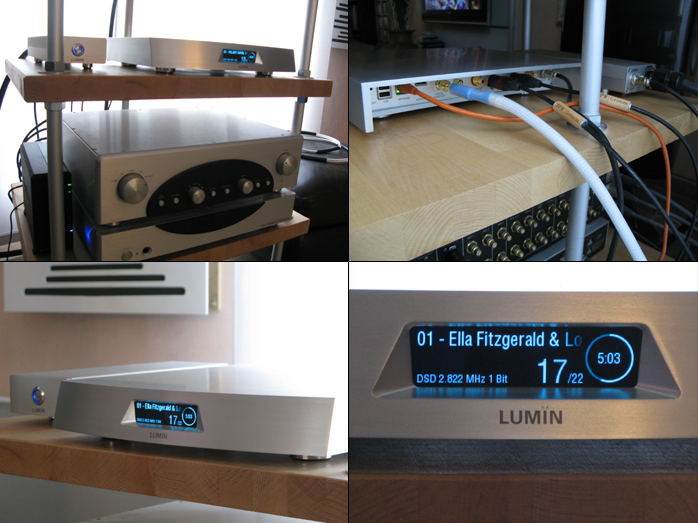This review page is supported in part by the sponsors whose ad banners are displayed below |
 |
 |
The native tag browsing skill allows one to easily sort any playlist by song title, album title, artist, composer (optional), genre and year. The browser panel can also be maximized to fill the screen entirely by hiding the playlist window. The Lumin app provides for several playback options such as play now (adds selection to the bottom of the playlist and skips to it for immediate playback), play next (adds after the current playing title), play later (adds selection to the bottom of the playlist) and play and replace (replaces the whole playlist with selected files).
|
 |
Beyond its undoubtedly brilliant aesthetics, the Lumin app also allows for default upsampling settings for each kind of file format. This makes for very interesting options between native playback (no upsampling) and various sample rates up to 192kHz and bit depths up to 24. Another option is the previously mentioned on-the-fly transcoding of DSD bitstream to PCM. There is no downsampling however and native files cannot be played back at lower than their original sample rates.
|
|
|
Recent firmware and application updates have enabled de-emphasis of 44.1kHz files directly from the settings panel. To explain what de-emphasis means, I need to refer to the pre-emphasis concept. Some early digital recording and playback gear used 14-bit converters despite dealing with 16-bit audio. They also used brickwall filters. The resultant noise could be made relatively quiet using pre-emphasis. This boosted the signal especially at its higher frequencies during the recording process before it was stamped to CD. Embedding flags in the disc's sub code told a CD player to apply de-emphasis during playback. Modern CD players have built-in de-emphasis in their analog outputs.
|
 |
By the late 1980s pre-emphasis stopped being used because reliable 16-bit DACs with oversampling and other technologies minimized the conversion and filtering noise without need for such preprocessing of the recordings. Most major-label CDs with pre-emphasis were manufactured in Japan during the early and mid 1980s. Besides being stored in the sub code along with the audio data, the pre-emphasis flag was also supposed to be stored in the table of contents. Yet many CDs' TOC says no pre-emphasis when in fact the sub code shows it is there. Generally once a CD has been ripped to any lossless audio format, the pre-emphasis flag is lost. It appears that there's no standard to store the emphasis flag in an actual file besides a cue sheet table which won't work with the Lumin. Lumin's de-emphasis for 44.1kHz CD files option is thus a manual switch to toggle the Wolfson DAC's de-emphasis on or off.
|
|
|
The DSD game. DSD streaming provided me with insanely fantastic results. The standard approach should be to use mainly DFF or DSF as the true SACD mother files. DSF is a stereo-only simplified form of DFF used for SACD mastering and 5.1-channel downloads. With this player it seems quite impossible to use DST direct-stream transfer files which are a compressed form of the original DFF or DSF files. With SACD production, compression is obligatory for 5 or 6 channels but can also be employed for simple 2-channel productions. The DST encoding algorithm is far from simple however and must be verified by a CRC cyclic redundancy check which is calculated over the DSD frame data and embedded in the DST file.
|
 |
You can get those files via ripping the ISO file of an SACD with a hacked PlayStation 3. The compressed DST files stored on an SACD disc obviously require less storage space than their original DFF/DSF uncompressed originals. But using such files adds extra decompression playback, hence the potential for more jitter and a less natural sound. This could explain why I had better results using the Lumin in native DSD mode than playing the equivalent discs over my Esoteric player which had to first 'unzip' the DST files on the actual discs.
|
 |
|
 |